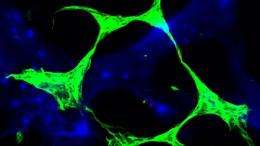Cell. Credit: Geraint Warlow from Creative Commons on Flickr
(Medical Xpress) -- New research from scientists at the University of Cambridge provides critical insight into the formation of autophagosomes, which are responsible for cleaning up cellular waste.
(Macro) autophagy is a bulk degradation process that mediates the clearance of long-lived or damaged proteins and organelles in cells. Autophagosomes are formed by double-membraned structures which engulf portions of cytoplasm and ultimately fuse with lysosomes, where the cellular waste is broken down.
The Rubinsztein lab at the Cambridge Institute for Medical Research have become increasingly involved in studying autophagy, since the time of their discovery that it regulates the levels of aggregate-prone proteins that cause many neurodegenerative diseases, including Huntington’s disease, mutant forms of alpha-synuclein (causing forms of Parkinson’s disease), and wild-type and mutant forms of tau (causing various dementias). The clearance of such proteins is retarded in cell models when autophagy is compromised. Rubinsztein’s group showed that drugs that enhance autophagy can alleviate the toxicity of such proteins in cell and animal models of such disease.
In addition to its roles in neurodegeneration, autophagy may have functions in a wide range of normal and disease states, including cancer, protection against certain infectious diseases, and ageing.
One of the key mysteries in the autophagy field has been the origin(s) of autophagosome membranes. Rubinsztein’s lab has made key contributions to autophagy cell biology by recently identifying the plasma membrane (the cell membrane) as a critical source of the membranes that form autophagosome precursors (published in Nature Cell Biology in 2010). These studies thus identified an initiating step and site in autophagosome formation that was previously unknown.
Their new research, funded by the Wellcome Trust, shows how these plasma membrane-derived autophagosome precursors mature into autophagosomes by undergoing fusion to increase their size, which they found was a prerequisite for the acquisition of the key autophagosome protein, LC3. This study thus identifies a new regulatable step in the formation of autophagosomes.
Professor David Rubinsztein said: “Autophagy is emerging as a key process regulating many diseases, however, there are still important mysteries to resolve regarding the origins of autophagosomes. We are excited that we have been able to contribute to characterizing some of the earliest stages of this process.”
More information: The paper, ‘Autophagosome Precursor Maturation Requires Homotypic Fusion’, was published last week in the journal Cell.
Provided by University of Cambridge




















